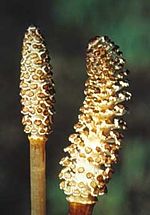Elater
- For the family of beetles commonly called "elaters", see Elateridae; for the genus within Elateridae, see Elater (beetle).
An elater is a cell (or structure attached to a cell) that is hygroscopic, and therefore will change shape in response to changes in moisture in the environment. Elaters come in a variety of forms, but are always associated with plant spores. In many plants that do not have seeds, they function in dispersing the spores to a new location. Mosses do not have elaters, but peristome which also change shape with changes in humidity or moisture to allow for a gradual release of spores.
Contents
1 Horsetail elaters
2 Liverwort elaters
3 Hornwort pseudo-elaters
4 References
Horsetail elaters
In the horsetails, elaters are four ribbon-like appendages attached to the spores. These appendages develop from an outer spiral layer of the spore wall. At maturity, the four strips peel away from the inner wall, except at a single point on the spore where all four strips are attached.
Under moist conditions, the elaters curl tightly around the spore. The wet spores tend to stick to each other and to nearby surfaces because of surface tension. When conditions are dry, the spores no longer stick to each other and are more easily dispersed. At that time, the elaters uncoil to extend out from the spore and will catch air currents. The fact that they are extended only when conditions are dry means that successful spore dispersal is more likely.

The mature strobili of a horsetail (Equisetum arvense).

A cross section through a horsetail strobilus, showing spores with elaters.
Liverwort elaters
In the liverworts, elaters are cells that develop in the sporophyte alongside the spores. They are complete cells, usually with helical thickenings at maturity that respond to moisture content.
In most liverworts, the elaters are unattached, but in some leafy species (such as Frullania) a few elaters will remain attached to the inside of the sporangium (spore capsule).

Spores and two elaters of the liverwort Ptilidium.
Hornwort pseudo-elaters
In the hornworts, elaters are branched clusters of cells that develop in the sporophyte alongside the spores. They are complete cells, usually without helical thickenings (except in the Dendrocerotaceae).
References
- Bold, Harold C., Alexopoulos, Constantine J., & Delevoryas, Theodore. (1987). Morphology of Plants and Fungi, (5th ed.). New York: Harper & Row. .mw-parser-output cite.citation{font-style:inherit}.mw-parser-output q{quotes:"""""""'""'"}.mw-parser-output code.cs1-code{color:inherit;background:inherit;border:inherit;padding:inherit}.mw-parser-output .cs1-lock-free a{background:url("//upload.wikimedia.org/wikipedia/commons/thumb/6/65/Lock-green.svg/9px-Lock-green.svg.png")no-repeat;background-position:right .1em center}.mw-parser-output .cs1-lock-limited a,.mw-parser-output .cs1-lock-registration a{background:url("//upload.wikimedia.org/wikipedia/commons/thumb/d/d6/Lock-gray-alt-2.svg/9px-Lock-gray-alt-2.svg.png")no-repeat;background-position:right .1em center}.mw-parser-output .cs1-lock-subscription a{background:url("//upload.wikimedia.org/wikipedia/commons/thumb/a/aa/Lock-red-alt-2.svg/9px-Lock-red-alt-2.svg.png")no-repeat;background-position:right .1em center}.mw-parser-output .cs1-subscription,.mw-parser-output .cs1-registration{color:#555}.mw-parser-output .cs1-subscription span,.mw-parser-output .cs1-registration span{border-bottom:1px dotted;cursor:help}.mw-parser-output .cs1-hidden-error{display:none;font-size:100%}.mw-parser-output .cs1-visible-error{font-size:100%}.mw-parser-output .cs1-subscription,.mw-parser-output .cs1-registration,.mw-parser-output .cs1-format{font-size:95%}.mw-parser-output .cs1-kern-left,.mw-parser-output .cs1-kern-wl-left{padding-left:0.2em}.mw-parser-output .cs1-kern-right,.mw-parser-output .cs1-kern-wl-right{padding-right:0.2em}
ISBN 0-06-040839-1. - Campbell, Douglas Houghton. (1918). The Structure and Development of Mosses and Ferns, (3rd ed.). New York: The Macmillan Company.
- Kenrick, Paul & Crane, Peter R. (1997). The Origin and Early Diversification of Land Plants: A Cladistic Study. Washington, D. C.: Smithsonian Institution Press.
ISBN 1-56098-730-8. - Smith, Gilbert M. (1938). Cryptogamic Botany, Volume II: Bryophytes and Pteridophytes. New York: McGraw-Hill Book Company.